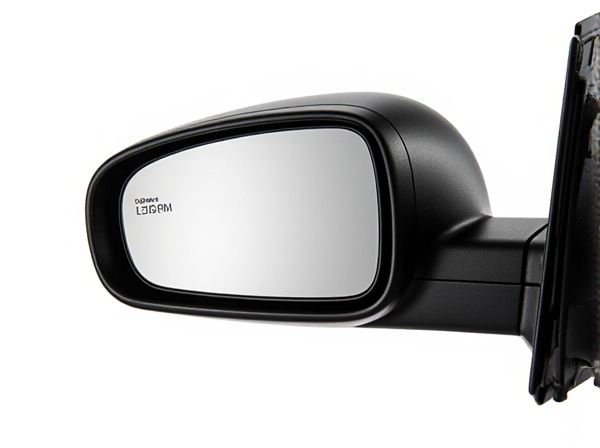
Photo illustration: Auto-Dimming Mirror vs Manual-Dimming Mirror
Auto-dimming mirrors automatically adjust to reduce glare from headlights, enhancing night driving safety and comfort without requiring manual intervention. Manual-dimming mirrors rely on a lever or switch to change the mirror's reflectivity, which can be less convenient and less responsive to changing light conditions. Choosing an auto-dimming mirror improves your driving experience by consistently minimizing glare and reducing eye strain.
Table of Comparison
| Feature | Auto-Dimming Mirror | Manual-Dimming Mirror |
|---|---|---|
| Function | Automatically reduces glare from headlights behind | Requires manual adjustment to reduce glare |
| Technology | Electrochromic glass with sensors | Reflective glass with physical dimmer switch |
| Safety | Enhances night driving safety by reducing eye strain | Dependent on driver's manual adjustment; less consistent |
| Convenience | Hands-free, automatic adjustment | Requires driver action to dim |
| Price | Higher cost due to advanced technology | Lower cost, simpler design |
| Installation | Often integrated with vehicle electronics | Standard, easy to install |
Introduction to Auto-Dimming and Manual-Dimming Mirrors
Auto-dimming mirrors use electrochromic technology to automatically adjust reflectivity based on light intensity, reducing glare from headlights at night. Manual-dimming mirrors require the driver to physically flip a tab or switch to change the mirror's angle and decrease glare. Both types enhance nighttime driving safety by improving visibility and minimizing eye strain, but auto-dimming mirrors provide a hands-free, responsive solution.
How Auto-Dimming Mirrors Work
Auto-dimming mirrors use electrochromic technology to reduce glare from headlights by automatically adjusting the mirror's reflectivity in response to light intensity detected by sensors. These sensors measure the light hitting the mirror's surface and send signals to an electrochromic gel layer within the mirror, which dims or brightens to enhance night driving visibility. Unlike manual-dimming mirrors, which require physical adjustment by the driver, auto-dimming mirrors provide continuous and automatic glare reduction for improved safety and comfort.
How Manual-Dimming Mirrors Function
Manual-dimming mirrors function through a simple mechanical pivot system that adjusts the mirror's angle to reduce glare by changing the reflection angle of light. Drivers flip a tab or lever to shift the mirror's reflective surface, directing bright headlight reflections away from the eyes and into a less intense position. This straightforward technology relies on physical manipulation, unlike auto-dimming mirrors that use electronic sensors and electrochromic glass to automatically adjust reflectivity.
Key Differences Between Auto and Manual Dimming
Auto-dimming mirrors use sensors to detect glare from headlights and automatically adjust the mirror's tint to reduce eye strain, while manual-dimming mirrors require the driver to flip a lever to change the mirror's angle and dim the reflection. Auto-dimming technology provides continuous adjustment for optimal visibility and enhances nighttime driving safety, whereas manual mirrors offer a fixed level of dimming depending on the position set by the driver. The integration of electrochromic glass in auto-dimming mirrors contrasts with the simple mechanical design of manual mirrors, influencing cost, convenience, and driver comfort.
Benefits of Auto-Dimming Mirrors
Auto-dimming mirrors automatically reduce glare from headlights behind the vehicle by using electrochromic technology, significantly improving night driving safety and reducing eye strain. These mirrors enhance driving comfort by maintaining optimal visibility without the need for manual adjustments, allowing drivers to focus more on the road. Compared to manual-dimming mirrors, auto-dimming versions offer seamless performance in changing lighting conditions, increasing overall convenience and safety.
Benefits of Manual-Dimming Mirrors
Manual-dimming mirrors offer cost-effective glare reduction by allowing drivers to quickly adjust the mirror angle to prevent headlight glare from trailing vehicles, enhancing night driving safety without relying on electronic components. These mirrors provide reliable performance with minimal maintenance, as their simple design eliminates potential failures associated with auto-dimming sensors and electronics. The manual adjustment feature gives drivers full control over glare management, making it a practical choice for budget-conscious vehicle owners seeking dependable and straightforward mirror functionality.
Drawbacks of Each Mirror Type
Auto-dimming mirrors can be costly and may require electrical power, making them less reliable in case of wiring issues or power failure. Manual-dimming mirrors demand frequent driver intervention which can be distracting and may lead to improper adjustment, reducing night driving safety. Both types face challenges in extreme temperatures where auto-dimming sensors may malfunction and manual mirrors become stiff or hard to adjust.
Cost Comparison: Auto vs Manual Dimming Mirrors
Auto-dimming mirrors typically cost between $150 and $400, reflecting their advanced light-sensing technology and convenience features, while manual-dimming mirrors range from $20 to $100, offering a budget-friendly option without electronic components. Installation expenses for auto-dimming mirrors can add $50 to $150 due to wiring requirements, compared to the minimal installation cost of manual mirrors, which often require no electrical work. Long-term value favors auto-dimming mirrors for frequent night drivers by reducing glare and eye strain, though manual mirrors remain a cost-effective choice for budget-conscious consumers.
Installation and Maintenance Considerations
Auto-dimming mirrors require electrical connections for power and sensors, making installation more complex compared to manual-dimming mirrors, which simply attach using existing mounts without wiring. Maintenance of auto-dimming mirrors involves periodically checking sensor functionality and electrical connections to ensure proper dimming response, whereas manual mirrors typically need only occasional cleaning and mechanical adjustment. Choosing between the two depends on the vehicle's electrical system compatibility and the owner's willingness to manage more intricate installation and upkeep procedures.
Which Mirror Type is Best for You?
Choosing between an auto-dimming mirror and a manual-dimming mirror depends on convenience and driving conditions. Auto-dimming mirrors automatically adjust to reduce glare from headlights, enhancing nighttime driving safety and reducing eye strain, making them ideal for frequent night drivers. Manual-dimming mirrors require manual adjustment, offering a lower-cost option but less convenience, suitable for drivers who rarely encounter intense glare.
 caratoz.com
caratoz.com